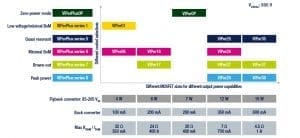ST’s VIPerPlus series of high-voltage converters combines an 800 V avalanche-rugged power MOSFET with a pulse width-modulator, and targets a wide variety of power supply circuits found in home appliances, home automation, power adapters, consumer products and automobiles, among others. Many features differentiate these families from their competitors and we will highlight three of them in this post: the avalanche-rugged design certified to up to 800 V, the Zero-Power mode, and the quasi-resonant operation.
800 V Avalanche-Rugged Power MOSFET
An electron avalanche in a semiconductor is a phenomenon in which free electrons (or holes) collide with bound electrons, knocking them out of their bound state. As a result new electron-hole pairs are created, which increases an electric current. In the case of a voltage converter, this phenomenon is often caused by high voltage spikes, which lead to a current flow, which in turns heats up the device and therefore further increases the current flow, and so on. It is easy to understand why such an avalanche can have irreversible effects on the electronic components unless a component is certified to tolerate high electron avalanches, the converter can only operate within narrow input voltages. The VIPer family embeds an 800 V avalanche-rugged power MOSFET, therefore accepting a wide range of voltage inputs.
This means that they are suited for designs that will operate in the most rugged environments such as cars, industrial power supplies, but can also in power adapters, and power supplies for consumer electronics, or air-conditioning systems, and other products where safety and reliability are paramount.
Zero-Power Mode
Connected devices must always be ready to receive or send information, but since they spend most of their time in a sleep state, it is important to reduce the power consumption of that state as much as possible. Between the rise of connected devices and the popularity of consumer appliances, energy consumed by devices that appear to be off has become a real issue. In 2011, it was estimated that 5% to 10 % of the total energy consumption of a household is wasted on products that were seemingly turned off. To make matters worse, the vast majority of consumers are unaware of that phenomenon, which means they often turn their devices off or put them in sleep mode thinking they don’t draw any energy, when they actually do.
This is why the VIPer0P offers Zero Power Mode. In a traditional device, the sleep or off state consumes power to feed the small portion of its circuit that will receive the command signal used to tell the system it is time to wake up or execute certain tasks. In the case of a Zero-Power mode, the components are designed to consume nothing in sleep or off mode. They are simply turned on by a button or a microcontroller that will send a very small amount of energy to wake the system and launch the necessary operations.
This explains why the VIPer0P is invaluable in small appliances, home automation systems, air conditioners or home lighting to name a few. Their Zero-Power Mode allows power supplies for those type of devices to comply with the most stringent industry regulations meant to reduce the energy consumption of households and businesses.
Quasi-Resonant Converter
Power MOSFETs offer higher switching frequencies – but this results in stresses and losses. Today, high-frequency converters use a resonant topology, which, to put it very simply, are characterized by the presence of an inductor and a capacitor. When turning off, voltage spikes take place because of leakage in the inductor. When turning on, the energy that was previously stored in the capacitor is sent throughout the switching circuits resulting in high losses. A quasi-resonant circuit tweaks this design to lower losses when the switch is turned on or off, and also reduces electromagnetic interference from the power supply.
The VIPerPlus series 5 offers quasi-resonant operation to greatly improve power efficiency in sensitive devices like battery chargers or notebook adapters, which must waste as little energy as possible while being compatible with a wide range of input voltages. Reducing electromagnetic interference also allows for smaller input filters, limiting the design’s footprint.
To learn more about the VIPer and VIPerPlus familie and how they can increase the efficiency of your design while reducing its complexity, visit our website.




